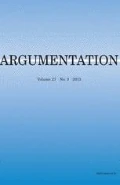Abstract
The nontechnical ability to identify or match argumentative structure seems to be an important reasoning skill. Instruments that have questions designed to measure this skill include major standardized tests for graduate school admission, for example, the United States-Canadian Law School Admission Test (LSAT), the Graduate Record Examinations (GRE), and the Graduate Management Admission Test (GMAT). Writers and reviewers of such tests need an appropriate foundation for developing such questions – they need a proper representation of phenomenological argumentative structure – for legitimacy, and because these tests affect people's lives. This paper attempts to construct an adequate and appropriate representation of such structure, that is, the logical structure that an argument is perceived to have by mature reasoners, albeit ones who are untrained in logic.
Similar content being viewed by others
REFERENCES
Adler, J. E.: 1994, 'Fallacies and Alternative Interpretations', Australasian Journal of Philosophy 72, 271–283.
Adler, J. E.: 1996, 'Charity, Interpretation, Fallacy', Philosophy and Rhetoric 29, 329–343.
Bach, K. and R. Harnish: 1979, Linguistic Communication and Speech Acts, The MIT Press, Cambridge.
Baum, R.: 1981, Logic, Second Edition, Holt, Rinehart and Winston, New York.
Ben-Yami, H.: 1996, 'Attributive Adjectives and the Predicate Calculus', Philosophical Studies 83, 277–289.
Berg, J.: 1987, 'Interpreting Arguments', Informal Logic 9, 13–21.
Brinton, A.: 1995, 'Analysis of Argument Strategies of Attack and Cooption: Stock Cases, Formalization, and Argument Reconstruction', Informal Logic 17, 249–258.
Cox, R. and P. Brna: 1995, 'Supporting the Use of External Representations in Problem Solving: The Need for Flexible Learning Environments', Journal of Artificial Intelligence in Education 6, 239–302.
Dummett, M.: 1978, 'The Justification of Deduction', Truth and Other Enigmas, Harvard University Press, Cambridge, pp. 290–318.
Govier, T.: 1995, 'Reply to Massey', in H. V. Hansen and R. C. Pinto (eds.), Fallacies: Classical and Contemporary Readings, Pennsylvania State University Press, University Park, pp. 172–180.
Gulliksen, H.: 1987, Theory of Mental Tests, Lawrence Erlbaum, Hillsdale, NJ.
Haack, S.: 1978, Philosophy of Logics, Cambridge University Press, Cambridge.
Johnson, R. H.: 1989, 'Massey on Fallacy and Informal Logic: A Reply', Synthese 80, 407–426.
Johnson-Laird, P. N.: 1983, Mental Models: Towards a Cognitive Science of Language, Inference, and Consciousness, Harvard University Press, Cambridge.
Lambert, K. and W. Ulrich: 1980, The Nature of Argument, Macmillan, New York.
Lord, F. M.: 1980, Applications of Item Response Theory to Practical Testing Problems, Lawrence Erlbaum, Hillsdale, NJ.
Lord, F. M. and M. R. Novick: 1968, Statistical Theories of Mental Test Scores, Addison-Wesley, Reading, MA.
Luebke, S.: 1995, 'Informal Logic Issues in a Practical Testing Context', in F. H. van Eemeren, R. Grootendorst, J. A. Blair and C. A. Willard (eds.), Proceedings of the Third ISSA Conference on Argumentation Vol. IV, International Centre for the Study of Argumentation, Amsterdam, pp. 31–41.
Massey, G.: 1975, 'Are There any Good Arguments that Bad Arguments are Bad?', Philosophy in Context 4, 61–77.
Massey, G.: 1995, 'The Fallacy Behind Fallacies', in H. V. Hansen and R. C. Pinto (eds.), Fallacies: Classical and Contemporary Readings, Pennsylvania State University Press, University Park, pp. 159–171.
Parsons, T.: 1996, 'What is an Argument?', Journal of Philosophy 93, 164–185.
Quine, W. V. O.: 1960, Word and Object, The MIT Press, Cambridge.
Read, S.: 1994, 'Formal and Material Consequence', Journal of Philosophical Logic 23, 248–265.
Roussos, L. A. and L. L. Norton: 1999, 'LSAT Item-Type Validity Study', Law School Admission Council Technical Report 98–01.
Sainsbury, M.: 1991, Logical Forms, Basil Blackwell, Oxford.
Salmon, W. C.: 1973, Logic, Second Edition, Prentice-Hall, Englewood Cliffs, NJ.
Slaney, J.: 1990, 'A General Logic', Australasian Journal of Philosophy 68, 74–88.
Walton, D.: 1995, A Pragmatic Theory of Fallacy, University of Alabama Press, Tuscaloosa.
Author information
Authors and Affiliations
Rights and permissions
About this article
Cite this article
Plumer, G. Phenomenological Argumentative Structure. Argumentation 15, 173–189 (2001). https://doi.org/10.1023/A:1011180401186
Issue Date:
DOI: https://doi.org/10.1023/A:1011180401186




